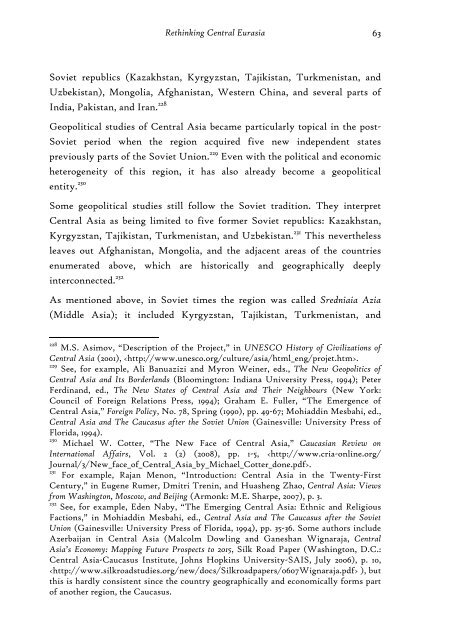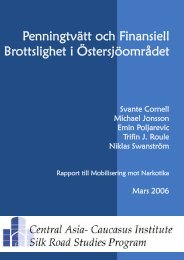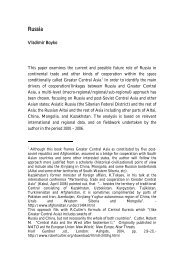Eurasianism and the Concept of Central Caucaso-Asia
Eurasianism and the Concept of Central Caucaso-Asia
Eurasianism and the Concept of Central Caucaso-Asia
Create successful ePaper yourself
Turn your PDF publications into a flip-book with our unique Google optimized e-Paper software.
Rethinking <strong>Central</strong> Eurasia 63<br />
Soviet republics (Kazakhstan, Kyrgyzstan, Tajikistan, Turkmenistan, <strong>and</strong><br />
Uzbekistan), Mongolia, Afghanistan, Western China, <strong>and</strong> several parts <strong>of</strong><br />
India, Pakistan, <strong>and</strong> Iran. 228<br />
Geopolitical studies <strong>of</strong> <strong>Central</strong> <strong>Asia</strong> became particularly topical in <strong>the</strong> post-<br />
Soviet period when <strong>the</strong> region acquired five new independent states<br />
previously parts <strong>of</strong> <strong>the</strong> Soviet Union. 229 Even with <strong>the</strong> political <strong>and</strong> economic<br />
heterogeneity <strong>of</strong> this region, it has also already become a geopolitical<br />
entity. 230<br />
Some geopolitical studies still follow <strong>the</strong> Soviet tradition. They interpret<br />
<strong>Central</strong> <strong>Asia</strong> as being limited to five former Soviet republics: Kazakhstan,<br />
Kyrgyzstan, Tajikistan, Turkmenistan, <strong>and</strong> Uzbekistan. 231 This never<strong>the</strong>less<br />
leaves out Afghanistan, Mongolia, <strong>and</strong> <strong>the</strong> adjacent areas <strong>of</strong> <strong>the</strong> countries<br />
enumerated above, which are historically <strong>and</strong> geographically deeply<br />
interconnected. 232<br />
As mentioned above, in Soviet times <strong>the</strong> region was called Sredniaia Azia<br />
(Middle <strong>Asia</strong>); it included Kyrgyzstan, Tajikistan, Turkmenistan, <strong>and</strong><br />
228 M.S. Asimov, “Description <strong>of</strong> <strong>the</strong> Project,” in UNESCO History <strong>of</strong> Civilizations <strong>of</strong><br />
<strong>Central</strong> <strong>Asia</strong> (2001), .<br />
229 See, for example, Ali Banuazizi <strong>and</strong> Myron Weiner, eds., The New Geopolitics <strong>of</strong><br />
<strong>Central</strong> <strong>Asia</strong> <strong>and</strong> Its Borderl<strong>and</strong>s (Bloomington: Indiana University Press, 1994); Peter<br />
Ferdin<strong>and</strong>, ed., The New States <strong>of</strong> <strong>Central</strong> <strong>Asia</strong> <strong>and</strong> Their Neighbours (New York:<br />
Council <strong>of</strong> Foreign Relations Press, 1994); Graham E. Fuller, “The Emergence <strong>of</strong><br />
<strong>Central</strong> <strong>Asia</strong>,” Foreign Policy, No. 78, Spring (1990), pp. 49-67; Mohiaddin Mesbahi, ed.,<br />
<strong>Central</strong> <strong>Asia</strong> <strong>and</strong> The Caucasus after <strong>the</strong> Soviet Union (Gainesville: University Press <strong>of</strong><br />
Florida, 1994).<br />
230 Michael W. Cotter, “The New Face <strong>of</strong> <strong>Central</strong> <strong>Asia</strong>,” Caucasian Review on<br />
International Affairs, Vol. 2 (2) (2008), pp. 1-5, .<br />
231 For example, Rajan Menon, “Introduction: <strong>Central</strong> <strong>Asia</strong> in <strong>the</strong> Twenty-First<br />
Century,” in Eugene Rumer, Dmitri Trenin, <strong>and</strong> Huasheng Zhao, <strong>Central</strong> <strong>Asia</strong>: Views<br />
from Washington, Moscow, <strong>and</strong> Beijing (Armonk: M.E. Sharpe, 2007), p. 3.<br />
232 See, for example, Eden Naby, “The Emerging <strong>Central</strong> <strong>Asia</strong>: Ethnic <strong>and</strong> Religious<br />
Factions,” in Mohiaddin Mesbahi, ed., <strong>Central</strong> <strong>Asia</strong> <strong>and</strong> The Caucasus after <strong>the</strong> Soviet<br />
Union (Gainesville: University Press <strong>of</strong> Florida, 1994), pp. 35-36. Some authors include<br />
Azerbaijan in <strong>Central</strong> <strong>Asia</strong> (Malcolm Dowling <strong>and</strong> Ganeshan Wignaraja, <strong>Central</strong><br />
<strong>Asia</strong>’s Economy: Mapping Future Prospects to 2015, Silk Road Paper (Washington, D.C.:<br />
<strong>Central</strong> <strong>Asia</strong>-Caucasus Institute, Johns Hopkins University-SAIS, July 2006), p. 10,<br />
), but<br />
this is hardly consistent since <strong>the</strong> country geographically <strong>and</strong> economically forms part<br />
<strong>of</strong> ano<strong>the</strong>r region, <strong>the</strong> Caucasus.






